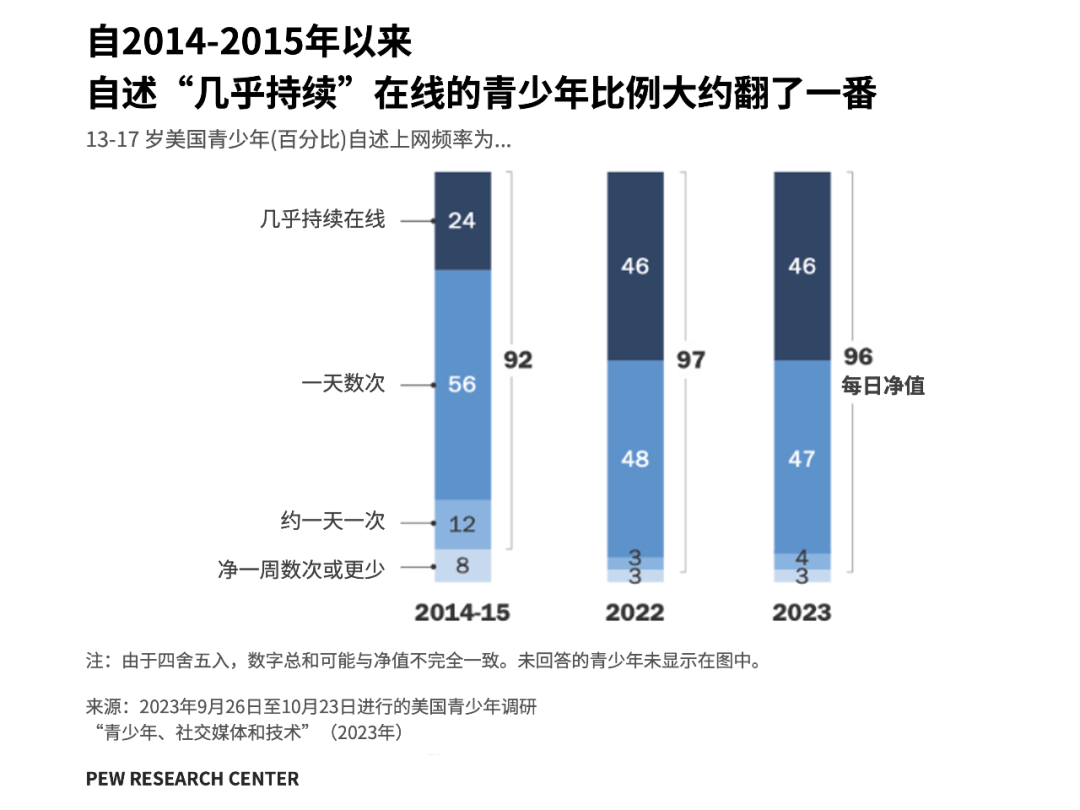The trend of using smartphone technology, accompanied by rising rates of anxiety and other related issues, is on the rise.
Image source: Unsplash/freestocks
Jessica Wanger
Deputy Editor for World Economic Forum Events
From 2014-2015 to 2023, the amount of time children spent "almost constantly online" roughly doubled, highlighting how technological advancements in recent years have reshaped childhood.
While the data hasn’t yet clearly revealed the impact of continuously increasing online time, there are signs that as smartphone availability and accessibility rise, so too do rates of anxiety, depression, and poor sleep among young people.
We need to adopt new approaches to address the emerging threats facing children and young people, while also reversing the growing trend of an increasingly anxious generation.
From the emergence of smartphone apps to the new incentive mechanisms on social media, the latest technological advancements have reshaped childhood—and simultaneously introduced a set of unique challenges specific to our era. Parents are increasingly becoming aware of these challenges.The data paint a complex picture: globally, mental health issues among young people are on the rise. While increased screen time and social media use have contributed to this trend, not all forms of digital engagement are harmful. Experts emphasize the need for a balanced approach to technology use, along with the redesign of digital tools, to ultimately enhance children’s well-being. Encouragingly, efforts to safeguard young people’s mental health are already underway in an increasingly digital world.Kathleen Pike, a psychology professor at Columbia University, believes there is no single story—by "story," she refers to children's life experiences. She draws on insights from writer Chimamanda Ngozi Adichie, who argued in her TED Talk that our lives and cultures are shaped by countless overlapping narratives.Today, the youth population aged 15 to 24 stands at 1.2 billion, accounting for 16% of the global population. Pike points out that this is clearly a complex and diverse story, and the data largely underestimates the population in low- and middle-income countries.However, the data clearly show that mental health issues are on the rise—and are set to continue increasing. In 2019, one in eight people worldwide (or 970 million individuals) suffered from a mental disorder, with anxiety and depression being the most common. By 2020, the number of people experiencing anxiety and depression had risen by 26% and 28%, respectively.The data also reveal that children and adolescents are not immune. According to a report by the World Health Organization, one in seven people aged 10–19 worldwide suffers from a mental disorder, accounting for 13% of the global disease burden in this age group. Depression, anxiety, and behavioral disorders are among the leading causes of illness and disability among young people, while suicide ranks as the fourth most common cause of death for adolescents aged 15–29. Meanwhile, rates of stress, fear, and loneliness remain particularly high—and continue to rise.What's wrong with today's young people?At the 2024 World Economic Forum Annual Meeting held in Davos, Switzerland, Nita Farahany, a leading scholar at Duke University who studies the ethical, legal, and societal implications of emerging technologies, shared her insights as a parent."I have an 8-year-old daughter. If she spends her time like most kids—meaning from now until she’s 18—she’ll likely spend about 4.8 years of her waking hours in front of electronic devices, and that worries me a lot. That translates to roughly 4.5 hours of daily screen time, completely immersed in the digital world. This isn’t a prediction for the future—it’s a reality backed by concrete data. And right now, it’s still unclear how this trend might reshape children’s cognitive landscapes."She added, "We are at a critical juncture. Children are being put through an experiment, and yet we don’t know what the consequences might be. Still, we do have some data that can raise awareness and encourage us to rethink how we deploy technology—while ensuring we respect children’s holistic development and well-being."From 2014-2015 to 2023, the amount of time children spent "almost constantly online" roughly doubled—from 3.5 hours per day to 7 hours or more daily. This indicates that the increase in online time has been steady, rather than a temporary phenomenon tied to the pandemic period, as many had initially believed.Teenagers' Online Proportion
Image source:Pew Research Center
There are many reasons why online time continues to rise—social media is one of them.Although the data haven’t yet clearly revealed the impact of increased online time, a noticeable upward trend has already emerged. As smartphone availability and accessibility continue to grow, so too have rates of anxiety, depression, and poor sleep quality.The reason behind this trend remains unclear, and its correlation with screen time isn’t immediately obvious—after all, part of the increase in online activity stems from greater opportunities for creativity, connectivity, as well as learning and immersive experiences. Yet intriguingly, as Farahany emphasizes, one study found that limiting college students’ screen time to just 30 minutes per day led to a significant reduction in feelings of depression and loneliness after just three weeks.Improving sleep quality appears to enhance mental health to some extent, but this can’t be the only reason.So, what actions must we take to address the new types of risks facing children and young people—and reverse the growing trend of an increasingly anxious generation?Farahany noted, "Part of the issue is that these platforms are intentionally designed around cognitive architectures, enticing users to keep engaging and using them." She emphasized that features like autoplay and intermittent rewards enhance the appeal of the social media experience while also creating peer pressure.If we can design with respect for children and all their needs, while recognizing that constant tech use isn’t the ultimate goal, the current state of technology will begin to shift. We must understand that interactions and connections among children—and even their engagement with nature—are absolutely essential."To design a world that fosters 'holistic development,' we must redesign technology," Farahany added. But to make this happen, we need to understand that not all screen time is harmful—balance is key."“We encourage the active, rather than passive, use of technology. The key is to clearly identify the benefits and figure out how technology can meet children’s needs.”Important efforts to achieve this goal are currently underway.Child-centered initiativeFinland has developed a specialized curriculum that leverages technology to help children enhance their critical thinking skills., skill levels and cognitive agility—starting from early childhood education—to teach children how to spot and respond to misinformation and false information.Similarly, the nonprofit organization Common Sense Education has launched a digital citizenship curriculum that teaches children the fundamentals of digital literacy, explores how digital literacy impacts them, and equips them with the skills to make informed choices—empowering them to thrive in an increasingly digital future.These actions will help children prepare for a world that’s becoming increasingly digital and immersive. But there’s still much more we can do.We must focus on technological design and undertake a redesign, including privacy-first social media platforms, as well as technologies that empower children rather than lure them into addiction.A new set of industry standards focused on children’s behavioral norms is working to bridge existing gaps. These standards take into account children’s unique vulnerabilities, fostering and supporting initiatives that empower them, while also driving the establishment of robust policy frameworks to safeguard their well-being. For instance, China’s new regulations have strengthened protections for children online, while the EU’s child-centered policies emphasize how increased access to mental health resources and funding can directly benefit kids.We need to make more concerted efforts like these, working together to prioritize the improvement of’s mental health. Social psychologist and author Jonathan Haidt notes that we’re witnessing parents who are overly protective of their children in the real world, yet fall short in providing the same level of protection in the virtual realm. He firmly urges parents, teachers, friends, and family members—anyone invested in enhancing the mental well-being of children and teens—to take immediate action.
The above content solely represents the author's personal views.This article is translated from the World Economic Forum's Agenda blog; the Chinese version is for reference purposes only.Feel free to share this on WeChat Moments; please leave a comment below the post if you’d like to republish.
Translated by: Di Chenjing | Edited by: Wang Can
The World Economic Forum is an independent and neutral platform dedicated to bringing together diverse perspectives to discuss critical global, regional, and industry-specific issues.
Follow us on Weibo, WeChat Video Accounts, Douyin, and Xiaohongshu!
"World Economic Forum"






